Rob Bartlett
Posted February 8, 2019
The United Teachers of Los Angeles (UTLA) has won a big, although limited victory. Fighting in a context of a school board controlled by corporate charter school advocates funded by Eli Broad and the Walton foundation in the second largest city in the United States in a state run by the Democratic Party they were able to dominate the discourse about education. The issues of class size and supports for students in the schools were widely accepted throughout the city and will reverberate across the country as teachers continue to fight the privatization of education and the lack of resources for public schools in all parts of the country.
Context
The UTLA strike would not have been possible without the 2012 strike of the Chicago Teachers Union (CTU). Until that pivotal strike, teachers and their unions, the American Federation of Teachers (AFT) and the National Education Association (NEA), were stuck in a spiral of concessions as corporate privatizers supported by both Democrats like Barack Obama and Republicans expanded the growth of charter schools in major cities across the country to the point where cities have the following percentages of students in charter schools: New Orleans 92%, Detroit 53%, the District of Columbia 43%, Philadelphia 32%, and Los Angeles with 20% charter students, but the largest total in the US of 156,000 students. As the number of charter school students increased, the resources devoted to public schools decreased, and loss of students led to the loss of programs and in the two worst cases a closure of public schools: the 48 schools closed in Chicago a year after the 2012 strike and the total charterization of New Orleans’ public schools.
It is a depressing list of statistics to show the growth of publicly funded, but privately run charter schools and the decade-long litany of blame directed at public schools, more specifically at teachers as the “problem” in education. As resources fell a series of bureaucrats at the national level like Secretaries of Education William Bennett to Arne Duncan declared that the problem was not a lack of resources but the quality of teachers and the answer was to promote nonunion charter schools where teachers could be more easily fired without going through the messy due process specified in union contracts. Factors like class size, and the preparation of students (which is strongly tied to socio-economic status) were ignored to focus on just “firing bad teachers” as Newsweek magazine proclaimed on its cover in March 2010.
2010 is when the Caucus of Rank and File Educators (CORE) won control of the CTU. In the two years between winning union office in Chicago and going on strike in 2012, the CTU worked relentlessly to change the culture of the CTU from a service model of a union to an organizing model, where members and the public were brought together around the mantra of “The Schools Chicagos Students Deserve.” This focus on framing the problems in education squarely as the lack of resources and disinvestment in schools led to the stunning victory of the CTU in the 2012 strike, much to the surprise of Mayor Rahm Emanuel and union leaders like Randi Weingarten of the AFT. After that strike, teachers throughout the US realized that it was possible to fight the privatizers and garner public support. Local unions like the St. Paul Federation of Teachers and Portland Association of Teachers published their own versions of “The Schools Students Deserve” and opposition caucuses in major cities, like Los Angeles, learned from the CTU strike so that when they won control of the union, they were able to start the preparation necessary to unite their members and build ties with the community in order to win a struggle against formidable foes.
The specific conditions in Los Angeles were not too dissimilar to those in Chicago, a Democratic leadership in the city, with an elected school board in the case of Los Angeles, where $13 million was spent in the recent election to give it a pro-charter majority. Funding in Los Angeles is also quite low compared to other large urban centers like New York City. Roughly $10,000 a year is spent per pupil in Los Angeles public schools compared to almost $18,000 per pupil in NYC. The growth of charter schools along with a decline in the number of students in LA is parallel to the same trend in Chicago. The inadequate funding in LA was effectively highlighted by UTLA when they contrasted the fact that California as a state has the 5th largest economy in the world, while they are 43rd in the nation in school spending and is 48th in student to teacher class-size ratio. Overtesting, one of the means used to demonstrate the “failure” of public education, is also rampant in LA. Other demands that the union and its community partners raised included providing a nurse in every school, an end to random searches of students, a focus on wraparound services by establishing community schools and charter school oversight.
As one of a dozen or so members of the “UTLA Solidarity Squad,” organized by Labor Notes and the United Caucuses of Rank and File Educators (UCORE), who volunteered to do strike support, I was able to compare the level of organization in LA to that in Chicago in 2012 and I believe it was superior to Chicago in several respects. I would say that in the two cities the union members were equally united and energized by the strike, but Los Angeles suffers from a geographical sprawl that makes it harder to hold centralized training functions. The level of internal organizing appeared better in LA, but they had the advantage of almost 4 years of preparation compared to only 2 in Chicago. I think there were some technological innovations that allowed UTLA to have better communication with regions and individual members, but the main thing that stood out was the eye-popping level of public support for teachers of over 80% in LA compared to “only” 67% in the 2012 Chicago strike. UTLA clearly did their homework and built what must be the foundations of any successful strike in the future.
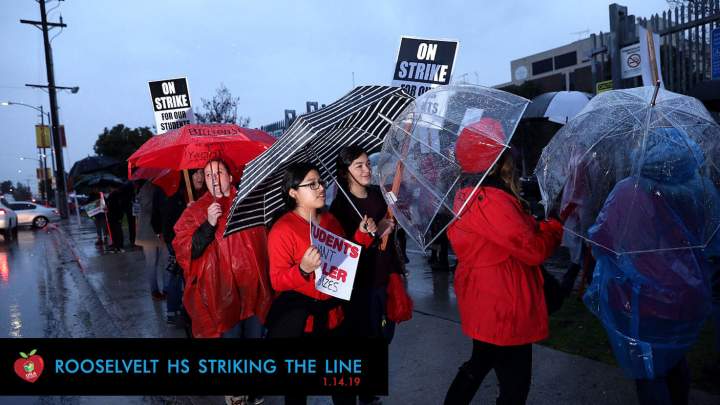
Issues
The issues in LA were many but boiled down to a focus on extreme class sizes that could be imposed under clause 1.5 in their old contract, which allowed the district to unilaterally impose class sizes into the 40’s due to financial needs of the district, the lack of support personnel in schools, which might have a nurse for only one day a week, caseloads of over 700 students per counselor, a similar lack of psychologists, the loss of $600 million a year from the Los Angeles Unified School District (LAUSD) to the charter schools, over-testing, lack of funding, and falling behind in wages in a very expensive city. It was impossible for the pro-charter LAUSD superintendent, Austin Beutner, and his allies on the school board and in the media to paint the teachers as “greedy.” The strategy of “bargaining for the common good” was utilized and was convincing for both teachers and parents. In the meantime, the LAUSD had built up an almost $2 billion surplus that they insisted they needed for future shortfalls.
In the face of this contrast the LA Times on January 27 wrote an assessment of the strike which included the following comments by UCLA education professor John Rogers:
What surprised Rogers was not just how strongly the union message came across, he said, but how ineffective the school district was in trying to persuade the public that it just doesn’t have the money to fix what ails L.A. Unified.
“The district leadership invested hugely in their public relations campaign,” Rogers said. “They brought in additional employees, they engaged with civic leaders, they had regular email chains.
“I didn’t see that from UTLA, but because their message had an underlying resonance, there’s been a connection that was sustained” throughout the strike with the public, he said. “It’s breathtaking how different this conversation is than a decade ago during the recession, when the conversations were so focused on bad teachers.”
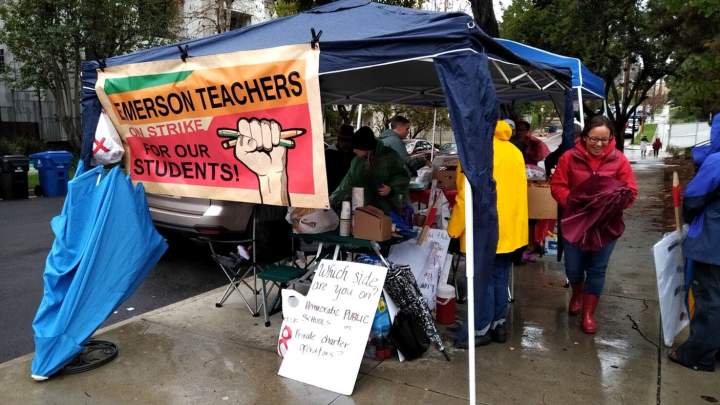
Genesis of the UTLA leadership
The Union Power leadership of UTLA is the result of a decades-long effort of rank-and-file members of the UTLA to change the leadership of the union. In 2006 the Progressive Educators for Action (PEAC), a social justice caucus in UTLA, originally founded in the 1990’s, formed an alliance with A. J. Duffy and the unified slate won office in UTLA. As a leadership it wasn’t unified in its approach, and four years later it was defeated by another slate run by Warren Fletcher, who espoused “bread and butter” issues. Due to limits written within UTLA bylaws presidents are “termed out” after one 4-year term. The current Union Power leadership comes out of the PEAC current, and president Alex Caputo-Pearl has been part of the series of attempts to change the focus of the union to a social justice orientation. PEAC has a much longer history than CTU’s CORE, but both learned from previous attempts to change the union.
In UTLA the Warren Fletcher leadership sold itself to the membership as able to win gains by focusing on better bargaining and promised that hiring a “professional” bargainer would win a better salary. UTLA under Fletcher organized a “Rally for a Raise,” a single-issue rally, while PEAC organized a contingent that called for things like more nurses and a vision of what a quality school would look like. The attempt to reform the union partially with Duffy was then contrasted with a narrowly focused vision of bargaining for teachers, not the common good. I think that the current “all in” policy of Union Power on broader social justice ideas has allowed them to unite the union and also build alliances with parents and community members that other perhaps well-meaning leaders like Duffy were simply unable to conceive of, and allowed Union Power to change the union from top to bottom.
This is one of the dilemmas facing union activists in both the AFT and NEA. Both unions have very progressive social platforms, but both organize locals in the image of the national unions and focus on the service model, not an outreach to parents, the community, and especially not to internally organizing the membership and empowering them. Granted this is not an easy task, but if anything is to be learned from both strikes in Chicago and Los Angeles the lesson must be that the only path to victory is the marriage of social justice issues in the community with self-organization within the union. Both national unions give support to struggles like that in Los Angeles, but neither leadership is capable of actually carrying out such a strategy. The struggle is on how to build a political force within each union that understands this necessary amalgam of social justice issues and democratic internal organization.
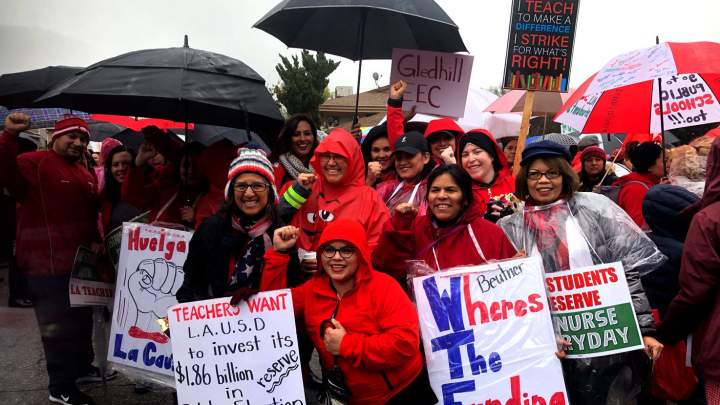
Preparing for the strike
UTLA hit the ground running in 2014 when the Union Power slate won. They immediately began to aggressively organize within the union by hiring experienced organizers from other unions and putting them to work to build the infrastructure of UTLA by making sure that there was a chapter chair in each of the 900 schools. Some schools are quite small, with as few as 3-5 teachers in some alternative sites, and being a chapter chair requires work, so there is a constant turnover. Then a process of training these job-site leaders needed to be initiated and expanded beyond just the technical aspects of running a meeting, but also in to how to spread the message that the union needed to convey to its members and project to the parents and community. Ultimately their goal was to establish Contract Action Teams at every school with one CAT member per 10 rank-and-file members per job site. This is a very ambitious goal and was achieved in many, but not all schools.
The logistics of how you internally organize in a large district are interesting in terms of dividing the regions, establishing intermediary leadership structures, but ultimately without a political message that resonates with both members and the community the logistics would be irrelevant. That sort of organization most competent unions can manage and improve on.
An aspect deserving more study is how the UTLA built coalitions like Reclaim Our Schools Los Angeles (ROSLA), which over 250 community organizations signed onto. I can’t claim to have any great insights into how that process worked, but I know that such efforts are always uneven, with greater or lesser participation in different sectors of the union and neighborhoods in the city. I do know that UTLA devoted material resources toward fostering this group, but I leave it others with more knowledge to further elucidate the process.
As a result of over three years of organizing 98% of UTLA members voting on strike authorization voted in favor. That tells you how well the UTLA leadership made the case for the necessity of a strike. The public opinion poll carried out by Loyola Marymount during the strike that showed 81% public support for the UTLA also tells you the effectiveness in messaging and building alliances.
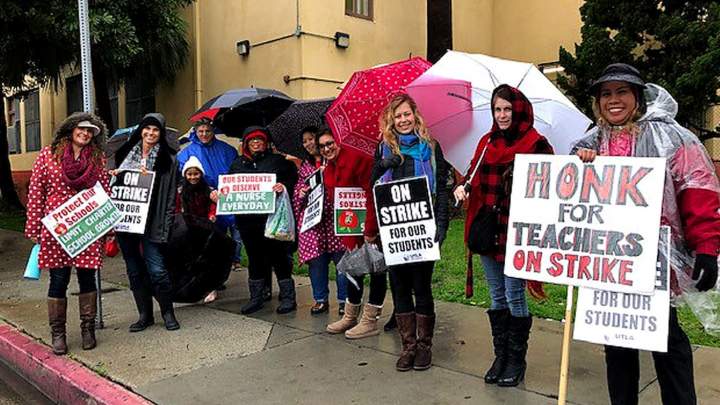
The strike itself
The strike was initially called for January 10th, but was delayed until the 14th due to a legal challenge by LAUSD. The union decided to postpone it until January 14th to forestall legal roadblocks.
The plan was for there to be picketing at every school site from 7am to 9 or 9:30 AM, and then on three days of the week all teachers were urged to join a massive rally in downtown LA. Following the rallies teachers would then return to schools for afternoon picketing. These rallies were indeed massive, and estimates of their size given by the police grew over the course of the 6 days from 45,000 to 60,000 people on the last Tuesday. There were difficulties in logistics in that teachers had to either drive to downtown LA or take a pretty inadequate mass transit system. It didn’t deter people from attending, nor did four days of rain in normally drought-stricken LA stop people. There are only about 33,000 LA teachers, so a considerable portion of the crowds were made up of parents and students.
The union had a system to keep track of how many members and parents participated in the picket lines, and it appears that over 90% of the teachers were on the line every day. I think that the size of the crowds overwhelmed the capacity of the UTLA infrastructure to do more than have a program, set a direction for a march, and just let the teachers and supporters carry it forward.
The most interesting days of the strike for me were Wednesday and Thursday, when local actions in the eight regions of the city were called. I was based in the West Valley, and for the Wednesday action we planned an 8:30 AM rally at a regional school board headquarters. By the time I got there at 9:30 hundreds of teachers had already arrived, and the police had blocked off the main street where we were planning to have a half-mile-long “billboard” of teachers with their signs. When the police closed both ends of the street there was no traffic and teachers spontaneously marched toward each end of the street where they waved their signs, banged drums, chanted and had a major presence on a major thoroughfare. There must have been 3,000 people, and more kept streaming into the site until we pulled everyone back to a central point prior to going back to afternoon pickets.
On Thursday in the West Valley there was a community meeting, which I didn’t attend, and another intersection rally, which I did. Once again, I got there before the official start time, but after hundreds had already assembled. I would estimate about 500 people were present and they had a novel (to me) tactic. There were about 100-150 people on each corner. About half of them waited to get the crossing light, marched to the other side, and waited for the light to change again. They continued to go in a clockwise pattern that allowed traffic to pass, while they were very visible with picket signs and loud with drums and chants. There was dancing on each corner to improvised sound systems and this went on for over two hours. The spirit and spontaneity demonstrated was inspiring and completely self-generated. The support shown by motorists through honking their horns was continuous and affirmed the righteousness of the strike. The West Valley is considered one of the more conservative areas of UTLA, but this shows how quickly teachers can take ownership and lead their own struggle.
During the strike if you wore your UTLA t-shirt anywhere, a restaurant, museum or on the street, it generated conversations with people, all positive, that reminded me of Chicago in 2012. It was a visceral expression of the public support for the strike. On Tuesday, the day the settlement was announced, there was a final rally in downtown LA which the police said 60,000 people attended. It was a victory celebration where the UTLA leadership was treated like rock stars. I was doing security around the stage and members would pass their phones to us to take pictures of Alex Caputo-Pearl, the union president, and eventually many insisted on taking selfies with him. A really memorable event, but it was then followed with a somewhat rushed ratification process that was forced on UTLA by LA mayor Eric Garcetti, who wanted students back in class the next day. The agreement was ratified by 81% voting in favor.
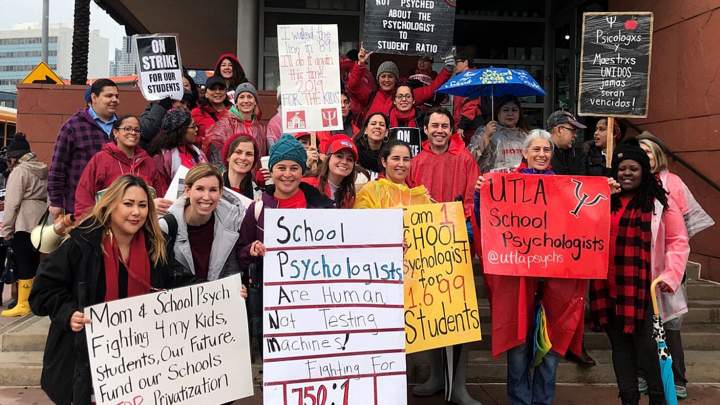
What was won?
It should be clear that the settlement was a victory, but it should also be noted that despite the unprecedented unity of teachers and support of the community it didn’t win enough for some members and many of the 19% voting against the agreement probably felt that they should have gotten more.
On the main issue of class size, the hated clause 1.5 was removed from the contract. The clause had allowed the district to unilaterally violate class size limits. Over the course of the contract class size would drop by 1 the first year, 1 more the second year, and 2 the last year. This is real movement in the right direction, but not sufficient. A number of teachers, especially in the k-3rd grade levels were bitter that “they didn’t win anything.” True, their class size wouldn’t be reduced, but elimination of 1.5 protects them from egregious overcrowding, and the addition of nurses to every elementary school 5 days a week is certainly in the interests of their students.
Further staffing wins involved a lower number of students per counselor, down to 500 from over 700. That too could be better. Librarians were guaranteed in all middle and high schools, also a clear win. Other things that are notable are the establishment of 20 community schools by June of 2019 and another 10 by June of 2020. These should be the models for all schools so they are in essence a pilot project. Of great importance to middle- and high-school students is the exempting of 28 schools from a “random” search policy. These are primarily done in schools that are overwhelmingly students of color. Once again, a step in the right direction, but not the elimination of such a racist policy entirely.
It should be also mentioned that teachers received a 6% pay raise, but that was something the district was willing to grant almost from the beginning. It is distinctly secondary to the gains mentioned above. On the issue of charter expansion and co-location language was put in the contract to begin to regulate co-location. The school board also passed a resolution on January 29th calling for a state study on charters and a moratorium on further charters until the study is completed. Since 2001 the number of charters has gone from 10 to 277 this year, and this has occurred in the context of the entire LAUSD system losing students. Student enrollment peaked in the 2002-3 school year at 747,000 students and was 573,000 students last year. These trends are unsustainable, and it is easy to predict that there will be a push to close and consolidate schools, something that Chicago and other cities have already experienced. The moratorium on charter expansion is good, but the conflict between these sectors and the lack of adequate funding is pitting them against each other, predictably. The struggle for more resources is crucial and will acquire further importance in the future.
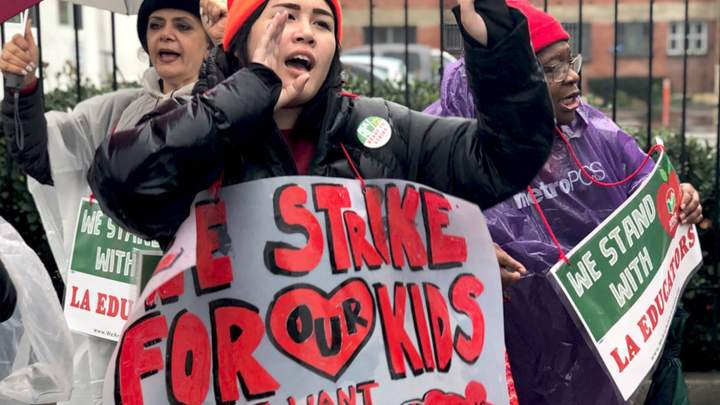
Some lessons learned
It is sobering to see such a magnificent struggle, which so fully involved both teachers and parents, come up against the issue of Where’s the funding? LAUSD had been hoarding a growing pot of money that was almost $2 billion this year. It is unclear how much they will have to dip into that sum to fund this agreement, but parts of the agreement are delayed for a year or two, especially on class size, so the full cost of the agreement is put off. The LA Times estimates that the district will have to spend $400 million of the $2 billion over the course of the contract, but that might be a low-ball estimate. Since most funding comes from the state, real changes to the way schools are funded need to be made by changing laws like Prop 13, the 1978 constitutional amendment which gave property tax relief not only to individuals but also to commercial and industrial properties. Without another source of revenue schools in LA and across the state will continue to be woefully underfunded. This is a fight that teachers face all across the US.
I think it is clear that there are real limitations to what was won. It should also be clear that the power that UTLA mobilized, while it could scarcely be greater, was insufficient to force the redistribution of wealth towards public education. That is a struggle that no single union or strike can win. If we take a slightly longer view going back to 2012 in Chicago and then forward through the 2018 strikes in West Virginia, Oklahoma, and Arizona we can see similar strengths and weaknesses. All those strikes, whether they were carried out by a militant union leadership or by rank-and-file teachers organized outside the traditional and weak union structures in right to work states, have run up against the intransigence of corporate power, regardless of how internally organized they were, or how much support they received from the public. All these struggles have had public support, but only those that had a leadership with a radical vision, as in Chicago and Los Angeles, were able to push beyond the ability to win wage increases for extremely underpaid and exploited teachers.
Chicago had an equally magnificent strike in 2012, and a year later the mayor closed 48 public schools and continued to expand charters. The support that Chicago teachers won by championing the schools that students deserve is still there, but it is a continual struggle to keep the teachers united to be able to fight the next fight — and there will be another one. If teachers are unable to be as united and outward looking, they will be vulnerable to the continual pressure of corporate powers, which have refused to support public education. All movements are subject to a continual pressure that tries to deflate them by making very partial concessions with a view to taking them back in the future.
While I can’t dictate strategy to the teachers in the “red for ed” movements, I think that the Chicago and LA examples of utilizing both the organizational power of a union and the mobilization of rank-and-file teachers is more capable of carrying out the sustained struggle that is needed. Some of the energy of teachers in the “red states” should be focused on exerting their power on the existing union structures to transform them, as they continue to build their power.
What is different today is the confluence of a growing number of teachers and union locals willing to buck the conservative approach that has dominated the labor movement since the concessionary attacks on unions began 30-some years ago. All teacher unions should be aggressively trying to organize charter school teachers and defuse the threat that charter schools pose to public education. The 2018 strike of Acero charter school teachers in Chicago showed that they too are oppressed by a lack of resources and are capable of being just as fierce defenders of the rights of their students as public-school teachers. The effort will take time, but the struggles that have erupted and are continuing to grow should help it.
The struggle within the established AFT and NEA local unions to transform them into versions of “the unions our teachers deserve” is ongoing and a difficult one. What is needed is a vision that moves both teachers and the community. There are enough examples now, with Chicago, LA, St Paul, West Virginia, Oklahoma, Arizona and hopefully places like Oakland and Denver, to provide a template of what is needed: a union committed to social justice for its students and community; a union leadership, and better still a caucus that leadership comes from, which embodies those principles and organizes around them; a union mobilization which strives to involve members and bring them into struggles in their communities that build real alliances; and finally a union policy to trust the creativity of our members and use it to build our strength to take on the rampant inequality of our society.
Rob Bartlett was a teacher an IFT/AFT member for 25 years and an associate member of CORE who joined the “UTLA Solidarity Squad,” a volunteer strike-support group organized by Labor Notes and the United Caucuses of Rank and File Educators (UCORE).
